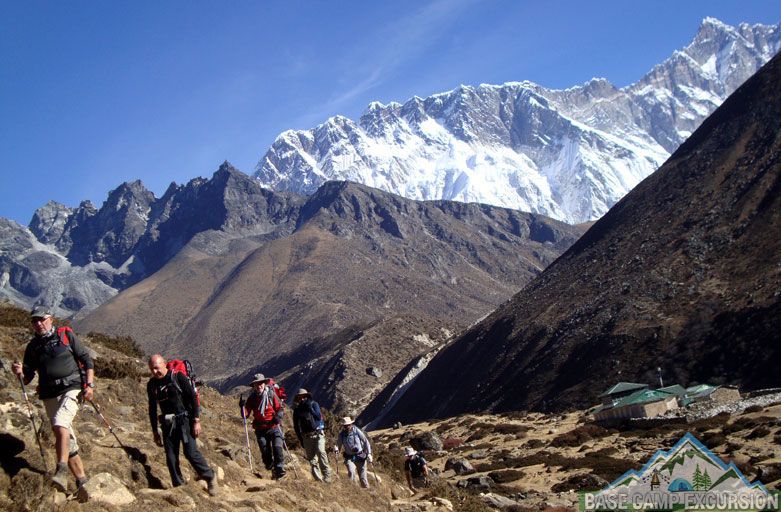Everest Base Camp Trek fitness requirements
Embarking on the Everest Base Camp Trek requires a solid level of physical fitness due to the demanding nature of the journey and the high-altitude environment. This iconic trek spans approximately 130 kilometers (80 miles) round-trip and involves a challenging ascent through rugged terrain, significant elevation gains, and fluctuating weather conditions. As trekkers navigate through the Himalayas, they face various physical demands that necessitate thorough preparation and fitness.
Cardiovascular endurance is a critical component of fitness for the Everest Base Camp Trekking. The trek involves long days of walking and climbing, often reaching altitudes where the air is thinner and oxygen levels are lower. To prepare, trekkers should engage in regular aerobic exercises such as running, cycling, or swimming, aiming to build stamina and improve heart and lung capacity. This type of training helps the body become more efficient at utilizing oxygen and managing the increased cardiovascular demands of trekking at high altitudes.
In addition to cardiovascular endurance, muscular strength and stamina are essential. The trek involves ascending and descending steep trails, which places a significant strain on the legs, particularly the quadriceps, hamstrings, and calves. Strength training exercises focusing on the lower body, such as squats, lunges, and step-ups, can enhance leg strength and reduce the risk of fatigue and injury. Core strength is also crucial for maintaining balance and stability on uneven terrain, so incorporating exercises like planks and abdominal crunches into your routine can be beneficial.
Acclimatization is another key aspect of preparing for the Everest Base Camp Trek. While this is not a physical fitness requirement per se, it is crucial to understand how the body responds to high altitudes. Trekkers should spend time at intermediate elevations and gradually increase altitude during their training to simulate the trekking conditions and help the body adapt. Familiarity with altitude-related symptoms and strategies for managing them can significantly enhance the trekking experience.
Flexibility and overall body conditioning are also important for preventing injuries and ensuring a comfortable trek. Stretching exercises, yoga, and activities that promote joint health can help keep the body limber and reduce stiffness during long days on the trail.
Lastly, mental preparedness is a vital component of fitness for the Everest Base Camp Trek. The trek can be mentally challenging due to its length, altitude, and unpredictable weather conditions. Developing a positive mindset, resilience, and mental fortitude through mental conditioning and visualization techniques can help trekkers remain focused and motivated throughout the journey.
In summary, achieving the fitness level required for the Everest Base Camp Trek involves a comprehensive approach that includes cardiovascular training, strength building, flexibility, acclimatization, and mental preparation. By committing to a well-rounded fitness regimen and gradually adapting to the trekking demands, individuals can enhance their chances of a successful and enjoyable adventure to Everest Base Camp.
Introduction to Fitness Requirements
Embarking on the Everest Base Camp Trek demands a considerable level of physical fitness due to the rigorous nature of the journey and the challenging high-altitude environment. The trek, spanning approximately 130 kilometers (80 miles) round-trip, involves navigating through rugged terrain, significant elevation gains, and potentially unpredictable weather conditions. Fitness requirements are not just about endurance but also about strength, flexibility, and acclimatization. Proper preparation ensures trekkers can handle the physical demands of the trek, reduce the risk of injury, and enhance the overall trekking experience. A well-rounded fitness regimen tailored to the specific challenges of high-altitude trekking is essential for a successful and enjoyable adventure.
Importance of Physical Fitness for Trekking
Physical fitness is crucial for the Everest Base Camp Trek due to the demanding nature of the trek, which includes long days of walking, steep ascents, and high-altitude conditions. A high level of physical fitness improves endurance, allowing trekkers to maintain a steady pace and manage the trek’s duration without excessive fatigue. Good fitness also enhances the body’s ability to adapt to the lower oxygen levels found at high altitudes, reducing the risk of altitude sickness. Additionally, being physically fit helps with the management of challenging terrains and inclines, providing better balance and stability. Overall, physical fitness contributes to a safer, more comfortable trekking experience and helps trekkers enjoy the journey with greater confidence.
Cardiovascular Endurance Standards
Cardiovascular endurance is a key component of the fitness required for the Everest Base Camp Trek. Trekkers should aim to build significant aerobic capacity to handle the trek’s extended walking hours and strenuous climbs. The goal is to improve the efficiency of the heart and lungs in delivering oxygen to the muscles. To meet this standard, a minimum of 30 to 60 minutes of moderate to high-intensity cardiovascular exercise, such as running, cycling, or swimming, should be performed at least three to five times a week. Training should include a mix of steady-state cardio and interval training to simulate the varying intensities of trekking. Building cardiovascular endurance helps the body cope with the high-altitude conditions and the demanding physical exertion of the trek.
Strength Training Recommendations
Strength training is essential for the Everest Base Camp Hiking due to the need for muscular endurance in the legs, core, and upper body. The trek involves significant uphill and downhill sections that place a strain on the lower body, particularly the quadriceps, hamstrings, and calves. Recommended strength training exercises include squats, lunges, step-ups, and deadlifts to build lower body strength. Core exercises such as planks and Russian twists are vital for stability and balance on uneven terrain. Additionally, incorporating exercises for the upper body, such as push-ups and shoulder presses, helps with carrying a backpack and maintaining overall body strength. A balanced strength training regimen, including two to three sessions per week, enhances muscular endurance and reduces the risk of injury during the trek.
Flexibility and Stretching Exercise
Flexibility and stretching are important components of a comprehensive fitness regimen for the Everest Base Camp Trek. Trekking involves prolonged periods of physical activity and exposure to varying terrains, which can lead to muscle stiffness and reduced range of motion. Incorporating flexibility and stretching exercises into your routine helps maintain joint health, prevent injuries, and improve overall comfort. Dynamic stretching, such as leg swings and walking lunges, is beneficial before workouts to prepare the muscles for exercise. Static stretching, including hamstring stretches, calf stretches, and hip flexor stretches, should be done after workouts to improve flexibility and aid in recovery. Regular stretching helps alleviate muscle tension, enhances mobility, and ensures that the body remains limber throughout the trek, contributing to a more enjoyable and injury-free experience.
Recommended Training Duration
Preparing for the Everest Base Camp Trek requires a significant investment of time and commitment to physical conditioning. Ideally, trekkers should start their training regimen at least three to six months before the planned trek. This extended preparation period allows for gradual improvement in cardiovascular endurance, muscular strength, and overall fitness. The training program should include a combination of aerobic exercises, strength training, and flexibility workouts. Initially, focus on building a base level of fitness with moderate-intensity workouts, gradually increasing the intensity and duration as the trek approaches. Incorporating long hikes or walks with a weighted backpack will help simulate trek conditions. Consistency is key, and dedicating at least four to five days per week to training will help ensure readiness for the physical demands of the trek.
Hiking Experience and Skill Levels
Hiking experience and skill levels play a crucial role in preparing for the Everest Base Camp Trek. While prior hiking experience is beneficial, it is not mandatory; however, having a foundation in hiking or trekking can significantly ease the transition to higher altitudes and more strenuous conditions. Beginners should seek opportunities for hiking on varied terrains and increasing elevations to build confidence and experience. Skill levels should also include familiarity with using trekking poles, navigating uneven trails, and managing physical exertion over extended periods. For those new to trekking, gradual exposure to longer and more challenging hikes, combined with appropriate training, will help build the necessary skills and endurance. Experienced hikers will find the trek more manageable but should still engage in specific training to adapt to the unique challenges of high-altitude trekking.
Medical Considerations and Health Assessments
Medical considerations are a critical aspect of preparing for the Mount Everest Base Camp Trek. Before embarking on the trek, it is advisable to undergo a thorough health assessment to ensure you are fit for high-altitude trekking. Consult with a healthcare provider to evaluate your overall health, particularly focusing on cardiovascular health, respiratory function, and any pre-existing conditions that may affect your ability to handle high altitudes. Conditions such as hypertension, heart disease, or respiratory issues require careful management and may necessitate specific precautions or medical advice. Additionally, consider a fitness assessment to gauge your physical readiness and identify any areas needing improvement. Proper medical evaluation helps ensure that you can safely undertake the trek and manage any health-related challenges that may arise during the journey.
Nutrition and Diet for Training
Proper nutrition and diet are essential for effective training and successful trekking. A balanced diet supports overall fitness, energy levels, and recovery. During training, focus on consuming a diet rich in carbohydrates, which provide the primary fuel for endurance activities. Include a variety of whole grains, fruits, and vegetables to ensure adequate vitamin and mineral intake. Protein is crucial for muscle repair and growth, so incorporate lean meats, fish, dairy, legumes, and nuts into your meals. Healthy fats, such as those from avocados, nuts, and olive oil, also support long-term energy and overall health. Staying hydrated is equally important; drink plenty of water throughout your training to maintain hydration levels. As the trek approaches, consider refining your diet to include foods that will be consumed during the trek, allowing your body to adjust and ensuring that you have a strategy for maintaining energy and nutrition on the trail.
Mental Fitness and Preparation
Mental fitness and preparation are vital for tackling the Everest Base Camp Trek, as the journey involves not only physical but also psychological challenges. Developing mental resilience helps manage the stress and demands of the trek, including long hours of walking, high-altitude conditions, and potential discomfort. Mental preparation can include visualization techniques, where you imagine successfully completing the trek and overcoming obstacles. Additionally, practicing mindfulness and stress-management techniques, such as meditation or deep-breathing exercises, can enhance focus and calmness. Setting realistic goals and maintaining a positive mindset are essential for navigating the trek’s challenges and staying motivated throughout the journey. Preparing mentally ensures that you are equipped to handle the trek’s demands, contributing to a more enjoyable and successful trekking experience.
Acclimatization Fitness Connections
Acclimatization and fitness are closely linked when preparing for the Everest Base Camp Trek. Physical conditioning helps the body adapt more effectively to high-altitude environments, where oxygen levels are lower than at sea level. A well-rounded fitness regimen that includes cardiovascular endurance, strength training, and flexibility can improve your body’s overall efficiency and resilience in high-altitude conditions. Cardiovascular fitness enhances the body’s ability to use oxygen more effectively, which is crucial as you climb higher. Strength training supports muscular endurance, which helps manage the physical strain of trekking at high altitudes. Flexibility improves overall mobility, reducing the risk of injury and aiding in recovery. Additionally, specific acclimatization strategies, such as gradual elevation gain and spending time at intermediate altitudes during training, can help your body adapt to reduced oxygen levels. Integrating acclimatization into your fitness routine prepares you for the unique challenges of high-altitude trekking and supports a more successful and comfortable experience.
Training Plans for Different Fitness Levels
Creating a training plan tailored to your fitness level is essential for effective preparation for the Everest Base Camp Trek. For beginners, the focus should be on gradually building cardiovascular endurance and strength. Start with low-intensity aerobic activities like walking or light jogging, and progressively increase intensity and duration. Incorporate basic strength training exercises for the legs and core to build a foundation. As fitness improves, introduce more challenging hikes and extended sessions with a weighted backpack to simulate trek conditions.
For intermediate trekkers, enhance your training by including more rigorous aerobic workouts, such as running or cycling, and increase the difficulty of strength exercises. Incorporate hill training or stair climbing to mimic the trek’s incline challenges. Adding interval training can improve cardiovascular efficiency and stamina.
Advanced trekkers should focus on fine-tuning their fitness and preparing for the specific demands of high-altitude trekking. Include high-intensity interval training (HIIT) and long-distance hikes with significant elevation gain. Prioritize endurance and recovery, and consider practice treks at altitude to further acclimatize.
Avoiding Injuries during Training
Injury prevention is a crucial aspect of training for the Everest Base Camp Hike. To minimize the risk of injury, it is important to follow a balanced training program that includes gradual progression, proper technique, and adequate rest. Begin with a warm-up to prepare muscles and joints for exercise, and always end with a cool-down and stretching to promote flexibility and reduce muscle soreness. Avoid overtraining by listening to your body and incorporating rest days to allow for recovery. Strength training should focus on proper form and controlled movements to prevent strain and overuse injuries. Additionally, wear appropriate footwear and gear during training to prevent injuries related to poor equipment. Pay attention to any signs of pain or discomfort, and address them promptly to avoid exacerbating injuries. By adopting a cautious and well-rounded approach to training, you can reduce the likelihood of injuries and better prepare for the trek.
Importance of Practice Treks
Practice treks are a valuable component of training for the Everest Base Camp Trek, offering several benefits that enhance preparedness. Engaging in practice treks helps simulate the conditions of the actual trek, allowing trekkers to experience long days of hiking, varying terrain, and the physical demands of carrying a backpack. These practice sessions can also help in acclimatization to higher altitudes and provide insight into how your body responds to similar conditions. Practice treks enable you to test and adjust gear, assess your physical readiness, and identify any issues that may need addressing before the main trek. Additionally, practice treks provide a mental preparation opportunity, helping you build confidence and experience in managing fatigue and navigating challenging terrain. Incorporating several practice treks into your training plan ensures that you are well-prepared for the physical and psychological demands of the Everest Base Camp Trek.
Conclusion and Final Fitness Tips
In conclusion, proper fitness preparation is essential for a successful and enjoyable Everest Base Camp Trek. A comprehensive fitness regimen that includes cardiovascular endurance, strength training, and flexibility is crucial for handling the trek’s physical demands and high-altitude conditions. Acclimatization plays a key role in preparing the body for reduced oxygen levels, and integrating gradual elevation gain into training can support this process. Tailor your training plan to your fitness level, and prioritize injury prevention by adopting a balanced approach to exercise and recovery. Practice treks are valuable for simulating trek conditions and building confidence. Finally, maintain a positive mindset and focus on gradual improvement throughout your training. By following these fitness guidelines and preparing thoroughly, you can enhance your trekking experience and achieve your goal of reaching Everest Base Camp with greater ease and enjoyment.
Keep an eye for more news & updates on Mamga Toto




